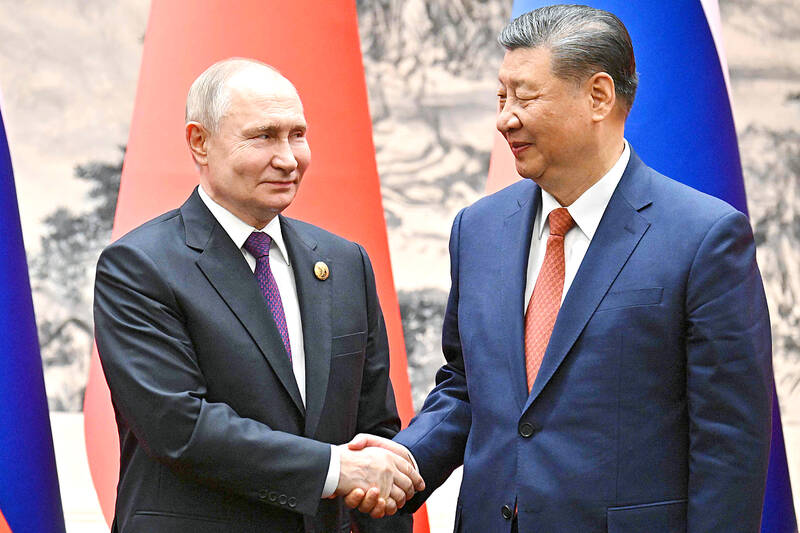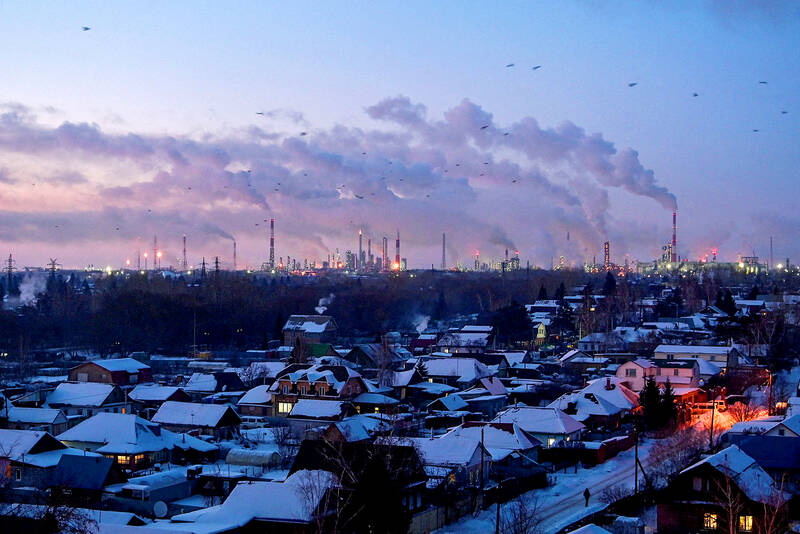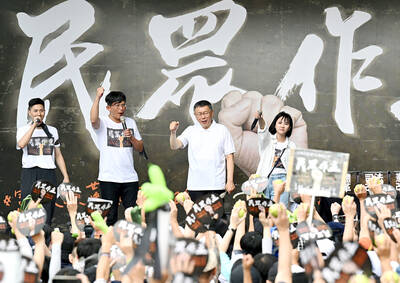On Sept. 1, President William Lai (賴清德) said “If it is for the sake of territorial integrity, why doesn’t [China] take back the lands occupied by Russia that were signed over in the treaty of Aigun? Russia is now at its weakest, right?”
“You can ask Russia [for the land back] but you don’t. So it’s obvious they don’t want to invade Taiwan for territorial reasons,” he added.
Lai was referencing an 1858 treaty under which, along with an 1860 convention, Russia annexed about one million square kilometers of Manchurian Qing territory in Outer Manchuria, including Haishengwei — today known as Vladivostok.

Photo: AFP
In preparing for columns and lectures on China’s resource deficiencies, naval chokepoints and potential for war, I have repeatedly examined the potential for the Chinese Communist Party (CCP) to make some kind of move on the Russian Far East, or even Siberia, taking all of Asian Russia to the Ural Mountains.
In spite of there being many compelling reasons why taking this territory would significantly benefit the CCP, I always came to the boring conclusion that they wouldn’t.
It would simply be easier to buy what they need from the Russians, who also are nuclear-armed and useful partners in helping destabilize the American-led world order. Not worth the cost and risks involved.

Photo: Reuters
However, recent developments and one strategic move by Ukraine could change everything and effectively hand over the region either stealthily or explicitly to the CCP.
JUICY TARGET
China struggles from serious resource deficiencies, especially water.
Other major deficiencies include relying on imported food and energy, with the bulk of Russia’s oil wells in Siberia. The Russian Far East has over seven million people, plenty of land and a population density of only 1.1 people per kilometer squared, while the three provinces in northeast China have nearly 100 million people and a population density of 124 people per kilometer squared.
In addition to oil and natural gas, the region has abundant ores, precious metals, rare earths, timber, wild game and fish. The long coastline also opens up many possibilities for breaking out of the first island chain.
China’s economy is suffering from multiple systemic problems and throwing money at unneeded infrastructure to meet GDP targets is an increasingly untenable strategy.
Siberia and the Russian Far East would need plenty of profitable, productive infrastructure if millions of Chinese moved in.
Meanwhile, Russia was already facing a demographic collapse, now made significantly worse thanks to the Ukraine war and hundreds of thousands of men fleeing abroad to avoid mobilization.
According to a Eurasia Daily Monitor report released in July, the population of the Russian Far East has dropped by nearly one-third since 1991, and the decline is accelerating.
As people leave, they are being replaced by migrants from Central Asia, North Korea and China. This is causing more Russian officials to warn that the demographic developments and efforts by China are threatening Moscow’s control of the region and even Russia’s territorial integrity.
STEALTH INVASION
The previously wary Russian President Vladimir Putin has invited more Chinese investment in the Far East, which has a high concentration of defense industries in desperate need of outside investment.
Russia intends to rope in China’s financial resources and manufacturing savvy to build two huge special economic zones near Vladivostok and Khabarovsk.
Russian media disclosed that during the Putin-Xi meeting in March last year, the Chinese agreed to directly invest more than US$160 billion in 79 major projects. By the end of last year, investment projects with Chinese participation in the Russian Far East had reached 49, totaling nearly US$9 billion invested.
The Chinese typically bring in large numbers of their own citizens to work on projects, hiring relatively few locals.
Putin may have opened the door to a stealth invasion of the Far East’s two largest cities. By rendering the local economies dependent on the Chinese, flooding the cities with Chinese people and greasing the wheels by bribing local officials, they will in effect be able to exercise control.
The CCP is not subtle. Previously, the two sides agreed to jointly administer the contested Bolshoy Ussuriysky Island, or Heixiazi Island, near the city of Khabarovsk, splitting it 50-50.
The Russian side is one of the economic zones agreed to last year, effectively giving the entire island to China. In August last year, China released a new edition “standard map” showing it as entirely Chinese territory and restoring Qing-era Chinese place names.
RUSSIAN WEAKNESSES
In mid-December, Russia’s Lieutenant General Igor Kirillov was remotely blown up by a Ukrainian agent by explosives planted in an electric scooter.
Ukrainian drones have been taking out Russian oil infrastructure which forced Russia to temporarily halt all exports for months in order to meet local demand. If Ukraine can take out enough infrastructure to force wells to stop pumping, they are at risk of freezing up, which permanently reduces output or forces them to redrill them entirely.
Previously foreign-owned wells will eventually stop functioning due to a lack of sanctioned parts and know-how.
A growing consensus is that Russia’s domestic defense industry will not be able to meet demand for many armaments like tank and artillery barrels by the end of next year and will face a crisis.
The fleet of civilian aircraft is increasingly suffering from a lack of parts and key personnel, resulting in grounded flights and planes being cannibalized for parts. Domestically-made planes also require foreign parts, and efforts to switch to local ones are struggling.
They have been in talks to have central Asian, Chinese or Indian airlines operate in Russia, but so far unsuccessfully.
Russia’s shadow merchant fleet is falling apart. This month two oil tankers fell apart and sank, while a third sent out a distress call — all in just a few days. There are not many ports friendly to Russian ships due to sanctions and they may now lose their Syrian naval base.
OBVIOUS CONCLUSION
Eventually, someone in Ukraine is going to look at a map and come to an obvious conclusion.
Blow up bridges and/or tunnels on the Trans-Siberian Railroad and the only road linking Asian and European Russia. Although they branch out into a network at both ends, there is a long stretch in Siberia where they each converge into one line.
There are thousands of targets and no way to adequately secure the entire route.
This cuts off goods from China, North Korea and the defense industry in Asian Russia.
Getting those into Russia would be exponentially more expensive and difficult by air, and they’d face a very long wait by sea.
Similarly, getting personnel across the Urals would also be more expensive, forcing economic damage on key industries, including oil, gas, mining and the military.
If the Ukrainian sabotage is well planned, it could take months or years to repair.
If successful, Putin will have no choice but to turn to the Chinese for help. At the very least they would extract considerable concessions that would expand their power in the region.
However, there would be little to stop China’s Peoples Liberation Army (PLA) taking it all. Russia’s only defense would be nuclear.
The PLA Rocket Force (PLAAF) is ramping up production of nuclear missiles, which the Pentagon this month estimated at 600 missiles. Russia has an estimated 1,710 ready to be fired at any time, but their reliability is questionable.
It seems more likely that China would want to avoid a war and instead conduct a stealth takeover, leaving the Russians nominally holding sovereignty but in practice under Chinese control.
However, in 1957, Mao Zedong (毛澤東) said to Soviet leader Nikita Khrushchev “We shouldn’t be afraid of atomic missiles. No matter what kind of war breaks out, conventional or nuclear, we will win… If the imperialists unleash war on us, we may lose more than 300 million people. So what? War is war.”
Donovan’s Deep Dives is a regular column by Courtney Donovan Smith (石東文) who writes in-depth analysis on everything about Taiwan’s political scene and geopolitics. Donovan is also the central Taiwan correspondent at ICRT FM100 Radio News, co-publisher of Compass Magazine, co-founder Taiwan Report (report.tw) and former chair of the Taichung American Chamber of Commerce. Follow him on X: @donovan_smith.

Not long into Mistress Dispeller, a quietly jaw-dropping new documentary from director Elizabeth Lo, the film’s eponymous character lays out her thesis for ridding marriages of troublesome extra lovers. “When someone becomes a mistress,” she says, “it’s because they feel they don’t deserve complete love. She’s the one who needs our help the most.” Wang Zhenxi, a mistress dispeller based in north-central China’s Henan province, is one of a growing number of self-styled professionals who earn a living by intervening in people’s marriages — to “dispel” them of intruders. “I was looking for a love story set in China,” says Lo,

It was on his honeymoon in Kuala Lumpur, looking out of his hotel window at the silvery points of the world’s tallest twin skyscrapers, that Frank decided it was time to become taller. He had recently confessed to his new wife how much his height had bothered him since he was a teenager. As a man dedicated to self-improvement, Frank wanted to take action. He picked up the phone, called a clinic in Turkey that specializes in leg lengthening surgery — and made a booking. “I had a lot of second thoughts — at the end of the day, someone’s going

In the next few months tough decisions will need to be made by the Taiwan People’s Party (TPP) and their pan-blue allies in the Chinese Nationalist Party (KMT). It will reveal just how real their alliance is with actual power at stake. Party founder Ko Wen-je (柯文哲) faced these tough questions, which we explored in part one of this series, “Ko Wen-je, the KMT’s prickly ally,” (Aug. 16, page 12). Ko was open to cooperation, but on his terms. He openly fretted about being “swallowed up” by the KMT, and was keenly aware of the experience of the People’s First Party

Standing on top of a small mountain, Kim Seung-ho gazes out over an expanse of paddy fields glowing in their autumn gold, the ripening grains swaying gently in the wind. In the distance, North Korea stretches beyond the horizon. “It’s so peaceful,” says the director of the DMZ Ecology Research Institute. “Over there, it used to be an artillery range, but since they stopped firing, the nature has become so beautiful.” The land before him is the demilitarized zone, or DMZ, a strip of land that runs across the Korean peninsula, dividing North and South Korea roughly along the 38th parallel north. This